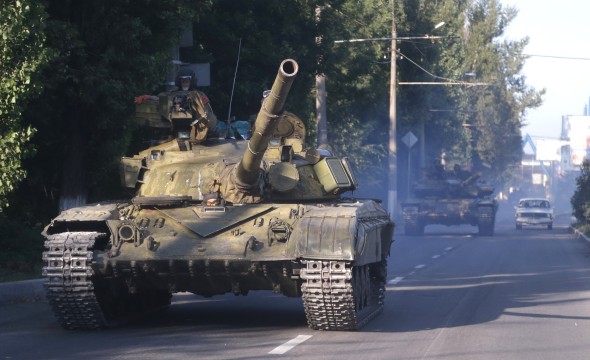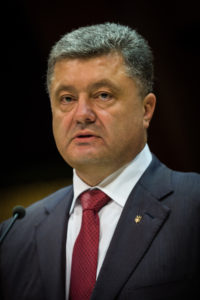Ukraine: Russian tanks have crossed the border
Daily News Article — Posted on August 27, 2014

Pro-Russian rebels ride on a tank in eastern Ukraine on Saturday, August 23, 2014.
(AP Photo)
- On April 7, 2014, following the 2014 Crimean crisis, separatists occupying the Donetsk Oblast administrative building declared independence from Ukraine and held a referendum on separating from Ukraine on May 11, 2014.
- Donetsk Oblast is an oblast (province) of eastern Ukraine.
- It is the most populated oblast with around 4.5 million residents.
- Its administrative center is the city of Donetsk; however, its Regional State Administration was relocated to Mariupol, a temporary measure due to the ongoing crisis in Donetsk.
- Pronunciation from Merriam-Webster:
Donetsk: \də-ˈnyetsk\
Mariupol: \ˌma-rē-ˈü-ˌpȯl\
(from Associated Press) KIEV, Ukraine — A column of Russian tanks and armored vehicles has crossed into southeastern Ukraine, away from where most of the intense fighting [between Ukrainian military and pro-Russian rebels] has been taking place, a top Ukrainian official said Monday.
Col. Andriy Lysenko, a spokesman for Ukraine’s National Security Council, told reporters that the column of 10 tanks, two armored vehicles and two trucks crossed the border near Shcherbak and that the nearby city of Novoazovsk was shelled during the night from Russia. He said they were Russian military vehicles bearing the flags of the separatist Donetsk rebels.
[“This morning there was an attempt by the Russian military in the guise of (pretending to be) Donbas fighters to open a new area of military confrontation in the southern Donetsk region,” Lysenko said, according to Reuters.]
In Moscow, Russian Foreign Minister Sergey Lavrov said Monday he had no information about the column.
 The reported incursion and shelling could indicate an attempt to move on Mariupol, a major port on the Azov Sea, an arm of the Black Sea. Mariupol lies on the main road between Russia and Ukraine’s Black Sea peninsula of Crimea, which Russia annexed [took over] in March. Capturing Mariupol could be the first step in building a slice of territory that links Russia with Crimea.
The reported incursion and shelling could indicate an attempt to move on Mariupol, a major port on the Azov Sea, an arm of the Black Sea. Mariupol lies on the main road between Russia and Ukraine’s Black Sea peninsula of Crimea, which Russia annexed [took over] in March. Capturing Mariupol could be the first step in building a slice of territory that links Russia with Crimea.
 Although Mariupol is in Ukraine’s separatist Donetsk region, most of the fighting between separatist rebels and Ukrainian troops has been well to the north, including around the city of Donetsk, the rebels’ largest stronghold. A full offensive in the south could draw Ukrainian forces away from the fight for Donetsk.
Although Mariupol is in Ukraine’s separatist Donetsk region, most of the fighting between separatist rebels and Ukrainian troops has been well to the north, including around the city of Donetsk, the rebels’ largest stronghold. A full offensive in the south could draw Ukrainian forces away from the fight for Donetsk.
Lysenko said Mariupol has enough defenders “to repel any attack of uninvited guests.”
Ukraine and the West (including the U.S.) say that Russia is supporting and supplying the rebels and that since mid-August, Russia has fired into Ukraine from across the border and from within Ukrainian territory. Moscow denies those allegations.
Fighting continued elsewhere in the east, notably around the town of Olenivka, 15 miles south of Donetsk. Lysenko said Monday about 250 separatists had been killed in that fighting, but did not specify in what time period. On Sunday, rebel leader Alexander Zakharchenko said two-thirds of Olenivka had been wrested away from Ukrainian control.
Ukrainian forces had made significant inroads against the separatists in recent weeks, but the rebels have vowed to retake lost territory.
Russia announced plans, meanwhile, to send a second aid convoy into rebel-held eastern Ukraine, where months of fighting have left many residential buildings in ruins.
Russia’s unilateral dispatch of over 200 trucks into Ukraine on Friday was denounced by the Ukrainian government as an invasion and condemned by the United States, the European Union and NATO. Even though the tractor-trailers returned to Russia without incident on Saturday, the announcement of another convoy was likely to raise new suspicions.
Russian Foreign Minister Lavrov said Monday that Russia had notified the Ukrainian government it was preparing to send a second convoy along the same route in the coming days, but Lysenko said he had no information on that plan.
Lavrov also said the food, water and other goods delivered to the hard-hit rebel city of Luhansk was being distributed Monday and that Red Cross workers were at talks on how best to distribute it. There was no immediate confirmation on that from the Red Cross.

Ukrainian President Petro Poroshenko
In sending in the first convoy, Russia said it had lost patience with what it called Ukraine’s stalling tactics. It claimed that soon “there will no longer be anyone left to help” in Luhansk, where weeks of heavy shelling have cut off power, water and phone service and made food scarce.
The Ukrainian government had said the aid convoy was a ploy by Russia to get supplies to the rebels and slow down government military advances.
On Sunday, as Ukraine celebrated the anniversary of its 1991 independence from Moscow, Ukrainian President Petro Poroshenko announced that the government would be increasing its military spending in a bid to defeat the rebels.
In rebel-held Donetsk, captured Ukrainian soldiers were paraded Sunday through the streets, jeered by the crowd and pelted with eggs and tomatoes (see second video under “Resources” below).
Note: This article first published August 25, 2014. Reprinted here for educational purposes only. May not be reproduced on other websites without permission from Associated Press. Visit the website at ap .org.
Background
- Ukraine gained independence after the collapse of the Soviet Union in 1991 and has since veered between seeking closer integration with Western Europe and reconciliation with Russia, which supplies most of the country's energy.
- Europe's second largest country, Ukraine is a land of wide, fertile agricultural plains, with large pockets of heavy industry in the east.
- While Ukraine and Russia share common historical origins, the west of the country has closer ties with its European neighbors, particularly Poland, and Ukrainian nationalist sentiment is strongest there.
- A significant minority of the population of Ukraine use Russian as their first language, particularly in the industrialized east. In Crimea, an autonomous republic on the Black Sea that was part of Russia until 1954, ethnic Russians make up about 60% of the population.
- Russia once again seized and annexed Crimea in March 2014, amid the chaos following the fall of President Viktor Yanukovych, plunging European into its worst diplomatic crisis since the Cold War. (from bbc.com)
On Ukraine, from the CIA World FactBook:
- Although final independence for Ukraine was achieved in 1991 with the dissolution of the USSR, democracy and prosperity remained elusive as the legacy of state control and endemic corruption stalled efforts at economic reform, privatization, and civil liberties.
- A peaceful mass protest "Orange Revolution" in the closing months of 2004 forced the authorities to overturn a rigged presidential election and to allow a new internationally monitored vote that swept into power a reformist slate under Viktor YUSHCHENKO.
- Subsequent internal squabbles in the YUSHCHENKO camp allowed his [pro-Russian] rival Viktor YANUKOVYCH to stage a comeback in parliamentary (Rada) elections and to become prime minister in August of 2006, and to be elected president in February 2010.
- In October 2012, Ukraine held Rada elections, widely criticized by Western observers as flawed due to use of government resources to favor ruling party candidates, interference with media access, and harassment of opposition candidates.
- President YANUKOVYCH's backtracking on a trade and cooperation agreement with the EU in November 2013 - in favor of closer economic ties with Russia - led to a three-month protest occupation of Kiev's central square.
- The [pro-Russian] government's eventual use of force to break up the protest camp in February 2014 led to all out pitched battles, scores of deaths, international condemnation, and the president's abrupt departure to Russia.
- An interim government scheduled new presidential elections for May 25, 2014.
- On March 1, 2014, one week after the overthrow in Kiev, Russian President PUTIN ordered the invasion of Ukraine's Crimean Peninsula claiming the action was to protect ethnic Russians living there.
- On March 16, 2014, a "referendum" was held regarding the integration of Crimea into the Russian Federation.
- The "referendum" was condemned as illegitimate by the Ukrainian Government, the EU, the US, and the UN General Assembly.
- Russian forces now occupy Crimea and Russian authorities claim it as Russian territory. The Ukrainian Government asserts that Crimea remains part of Ukraine.
